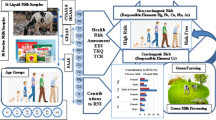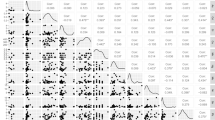Abstract
Human breast milk and infant formula milk powder (IFMP) are the main nutritional sources for infants. In the literature, there is a lack of studies concerning levels of trace elements in human milk and IMP in Jordan. The aim of this research was the determination of levels of 24 trace elements in human breast milk from Jordanian mothers (n = 76) and IFMP from Jordanian market (n = 22). Elements were classified to essential (Mg, Fe, Zn, Cu, Mn, Ni, Cr, Mo, Co, and Se), non-essential (Al, Ag, Ba, Bi, Cs, Ga, Li, Rb, Sr, U, and V), and potentially toxic (As, Cd, and Pb). Inductively coupled plasma-mass spectrometry (ICP-MS) following a microwave digestion of samples with concentrated nitric acid and hydrogen peroxide was performed. Our results featured levels of each targeted element in human milk and IFMP (mean, standard deviation (SD), median, and range). Statistical analysis included a one-way analysis of variance (ANOVA), and Pearson’s correlations. A sample toxicological analysis study for toxic elements As, Cd, and Pb was performed, and results were inspected. Levels of most elements including toxic elements are larger than in human milk samples, and comparable to in IFPMs to literature results. Mean levels of majority of the elements (17 out of 24) in human milk were significantly different than respective means in IFMP solutions. Positive correlation was observed between total toxic elements and Al, Cu, and Fe in human milk samples. Results of toxicological analysis demonstrated that most of IFMP samples do not represent a health hazard to infants regarding As, Cd, and Pb. The same applies for Cd in human milk samples. However, levels of As and Pb in 70% of human milk samples exceed the provisional tolerable weekly intake (PTWI) for As and Pb.
Similar content being viewed by others
Data Availability
All data generated or analyzed during this study are included in the published article and its supplementary information files.
Abbreviations
- ANOVA:
-
Analysis of variance
- bw:
-
Body weight
- ET-AAS:
-
Electrothermal atomization-atomic absorption spectrometry
- FAAS:
-
Flame atomic absorption spectrometry
- IFMP:
-
Infant formula milk powder
- HPW:
-
Home purified water
- ICP-MS:
-
Inductively coupled plasma-mass spectrometry
- ICP-OES:
-
Inductively coupled plasma-optical emission spectrometry
- LOD:
-
Limit of detection
- LOQ:
-
Limit of quantitation
- MLOD:
-
Method limit of detection
- MLOQ:
-
Method limit of quantitation
- NAA:
-
Neutron activation analysis
- nd:
-
Not detected
- PTWI:
-
Provisional tolerable weekly intake
- RSD:
-
Relative standard deviation
- SD:
-
Standard deviation
- WHO:
-
World Health Organization
- HPW:
-
Home purified water
References
Parr RM (1983) Trace elements in human milk. IAEA Bull 25:7–15
Ballard O, Morrow AL (2013) Human milk composition nutrients and bioactive factors. Pediatr Clin N Am 60:49–74
Lonnerdal B (1997) Effects of milk and milk components on calcium, magnesium, and trace element absorption during infancy. Physiol Rev 77:643–669
Friel JK, Andrews WL, Jackson SE, Longerich HP, Mercer C, McDonald A, Dawson B, Sutradhar B (1999) Elemental composition of human milk from mothers of premature and full-term infants during the first 3 months of lactation. Biol Trace Elem Res 67:225–247
Björklund KL, Vahter M, Palm B, Grandér M, Lignell S, Berglund M (2012) Metals and trace element concentrations in breast milk of first time healthy mothers: a biological monitoring study. Environ Health 11:1
Stawarz R, Formicki G, Massanyi P (2007) Daily fluctuations and distribution of xenobiotics, nutritional and biogenic elements in human milk in southern Poland. J Environ Sci Health Part A 42:1169–1175
Kaur K, Gupta R, Saraf SH, Saraf SK (2014) Zinc: the metal of life. Compr Rev Food Sci Food Saf 13:358–376
Mohd-Taufek N, Cartwright D, Davies M, Hewavitharana AK, Koorts P, Show PN, Sumner R, Lee E, Whitfield K (2016) The simultaneous analysis of eight essential trace elements in human milk by ICP-MS. Food Anal Methods 9:2068–2075
Hannan MA, FarajI Tanguma J, Longoria N (2009) Maternal milk concentration of zinc, iron, selenium, and iodine and its relationship to dietary intakes. Biol Trace Elem Res 127:6–15
O’Connor NR (2009) Infant formula. Am Fam Physician 79(7):565–570
Labiner-Wolfe J, Fein SB, Shealy KR (2008) Infant formula-handling education and safety. Pediatrics 122(2):S85–S90
Schuhmacher M, Bosque MA, Domingo JL, Corbella J (1991) Dietary intake of lead and cadmium from foods in Tarragons Province. Spain Bull Env Contam Toxicol 46:320–328
Mertz W (ed) (1986) Trace elements in human and animal nutrition, 5th edn. Academic Press, New York, pp 110–118
Zheng N, Wang Q, Zhang X, Zheng D, Zhang Z, Zhang S (2007) Population health risk due to dietary intake of heavy metals in the industrial area of Huludao city China. Sci Total Environ 387:96–104
Jurowski K, Szewczyk B, Nowak G, Piekoszewski W (2014) Biological consequences of zinc deficiency in pathomechanisms of selected diseases. J Biol Inorg Chem 19:51069–51079
Pinto M, Almeida A (2018) Trace elements in human milk. In: Saleh H (ed) human health and environment, IntechOpen pp 85-109
Klein D, Breakey AA, Scelza B, Valeggia C, Jasienska G, Hinde K (2017) Concentrations of trace elements in human milk: comparisons among women in Argentina, Namibia, Poland, and the United States. PLoS One 12:1–16
Kim SY, Park JH, Kim EA, Lee-Kim YC (2012) Longitudinal study on trace mineral compositions (selenium, zinc, copper, manganese) in Korean human preterm milk. J Korean Med Sci 27:532–536
Bassil M, Daou F, Hassan H, Yamani O, Kharma JA, Attieh Z, Elaridi J (2018) Lead, cadmium and arsenic in human milk and their socio-demographic and lifestyle determinants in Lebanon. Chemosphere 191:911–921
Dominguez A, Paz S, Rubio C, Gutièrrez Á, González-Weller D, Revert C, Hardisson A (2017) Essential and toxic metals in infant formula from European community. Open Access J Toxicol 2(2). https://doi.org/10.19080/OAJT.2017.02.555585
Sager M, McCulloch CR, Schoder D (2018) Heavy metal content and element analysis of infant formula and milk powder samples purchased on Tanzanian market: international branded versus black market products. Food Chem 255:365–371
Chajduk E, Pyszynska M, Polkowska-Motrenko H (2018) Determination of trace elements in infant formulas available in Polish market. Biol Trace Elem Res 186:589–596
Jurowski K, Krośnaik M, Folta M, Cole M, Piekoszewski W (2019) The toxicological analysis of lead and cadmium in prescription food for special medical purposes and modified milk products for newborns and infants available in Polish pharmacies. J Trace Elem Med Biol 51:73–78
Jurowski K, Krośnaik M, Folta M, Tatatar B, Cole M, Piekoszewski W (2019) The analysis of Cu, Mn and Zn content in prescription food for special medical purposes and modified milk products for newborns and infants available in Polish pharmacies from nutritional and toxicological point of view. J Trace Elem Med Biol 53:144–149
Jurowski K, Krośnaik M, Folta M, Tatatar B, Cole M, Piekoszewski W (2019) The toxicological analysis of Ni and Cr in prescription food for special medical purposes and modified milk products for newborns and infants available in pharmacies in Poland. Biol Trace Elem Res 192:129–135
Al-Sheyab NA, Al-Qudah KM, Tahboub YR (2015) Levels of perfluorinated compounds in human breast milk in Jordan: the impact of socio-demographic characteristics. Environ Sci Pollut Res 22:12415–12423
Rey-Crespo F, Miranda M, López-Alonso M (2013) Essential trace and toxic element concentrations in organic and conventional milk in NW Spain. Food Chem Toxicol 55:513–518
Khatami SF, Paraversh P, Konchak S, Khorsandi J (2014) Breast milk concentration of rubidium in lactating mothers by instrumental neutron activation analysis method. Iran J Pediatr 24(6):692–696
Li C, Solomons N, Scott M, Koski G (2016) Minerals and tracr elements in human milk are associated with Guatemalan infant anthropometric outcome within the first 6 months. J Nutr 146(10):2067–2074
WHO-EUROPE, ENHIS (2009) https://www.euro.who.int/__data/assets/pdf_file/0004/97042/4.4.-Exposure-of-children-to-chemical-hazards-in-food-EDITED_layouted.pdf
Alomary A (2013) Determination of trace metals in drinking water in Irbid city-northern Jordan. Environ Monit Assess 85:1969–1975
Massadeh A, El-Rjoob A, Alomary M (2020) Investigation of metal levels in Artemisia herba-Alba medicinal plant and soil samples collected from different areas in Jordan country. Soil Sediment Contam Int J:1–15. https://doi.org/10.1080/15320383.2020.1832041
World Health Organization (2017). Guidelines for drinking-water quality. https://apps.who.int/iris/handle/10665/254637
Funding
This project was funded by the Deanship of Scientific Research at Jordan University of Science and Technology, Irbid, Jordan (6/2016). We would like to thank all who participated in this research and provided human milk samples.
Author information
Authors and Affiliations
Corresponding author
Ethics declarations
Conflict of Interest
The authors declare that they have no conflict of interest.
Additional information
Publisher’s Note
Springer Nature remains neutral with regard to jurisdictional claims in published maps and institutional affiliations.
Rights and permissions
About this article
Cite this article
Tahboub, Y.R., Massadeh, A.M., Al-sheyab, N.A. et al. Levels of Trace Elements in Human Breast Milk in Jordan: a Comparison with Infant Formula Milk Powder. Biol Trace Elem Res 199, 4066–4073 (2021). https://doi.org/10.1007/s12011-020-02547-4
Received:
Accepted:
Published:
Issue Date:
DOI: https://doi.org/10.1007/s12011-020-02547-4




